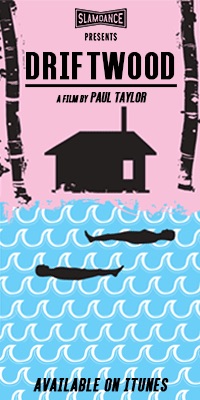Paul Taylor is to be heartily commended for his feature film debut, Driftwood. Beyond the substance of the story – which does matter, and we’ll get to that – the film has the audacity to weave a cohesive and absorbing narrative without a single bit of dialogue. Now, let’s think about that for a minute. This isn’t a silent movie. Sounds are fully in play and used to great advantage. And even Silent Movie Era plots were mostly abetted by dialogue cards, filling in the gaps where visual language didn’t do the job. To be sure – a great many experimental/Avant Garde films have similarly eschewed verbal communication in favor of purely cinematic expression. But by and large, these films are not linear narratives, and in fact, are often partially defined by their conscious lack of traditional structured recounting. So even in the fulness of the history of movies, Driftwood is in a pretty small club.

Joslyn Jensen in DRIFTWOOD
What makes the film truly stand out is just how well Taylor has executed his vision. To begin with, he made a really smart choice to help the story do its job without unnecessary obstacles: it’s well-established early on as being an allegory. That means, no need to overexplain how we get from A to B, no need to find out what the “backstory” of the characters are, no need to ponder “why is so-and-so not doing x or y” – it’s just a stand-in for reality (a very close stand-in, in some ways). The characters are archetypes, but really specific and fleshed-out archetypes. Even more cleverly, Taylor seamlessly blends the classically-inspired fable framework into a modern habitat which just about anyone can ease into. It’s like a wordless 21st century Aesop tale. Having set up a solid yet safe structure, the writer/director and his cast were then free to do the hard work of foundational acting within a carefully-constructed mise en scène. Imagine that – just what you see and hear on the screen telling the whole yarn without saying a word. It’s like somebody discovered cinema all over again after 120 years’ worth of exposition-binging through almost every movie ever made.

DRIFTWOOD
So, OK, yeah, Taylor did something so atavistically fundamental it’s almost novel. as giddy as that makes the cinephile in me, we can’t stop there. What really matters is, did it work? Does the film have any real value beyond its bold conceit? And the answer is yes, very much yes, so much yes. Which is where we come back to the substance of the narrative. The “driftwood” in the story is a woman who has washed up on the shore. Disoriented and apparently a “clean slate” of a person, signifying either total amnesia or a return to the infant’s consciousness, she is essentially a helpless and lost child inhabiting the body of a desirable young woman. She is “found” and “rescued” (or is it kidnapping?) by an older man, a fully matured, self-reliant and resourceful male who at first seems to be entirely benevolent. He bathes her, feeds her, clothes her, all without any hint of expecting anything in return. And the film goes from there, exploring the nature of actions and reactions, the formation of emotions and desire, and most of all, power relationships and the common moral failure of those who hold an advantage over others. All of it is transmitted effectively, with very few lulls. Each scene is pregnant with meaning, faithfully delivering another generation of growth for the story by sequence’s end. The sequences together snowball into the greater expectancy of the narrative’s course, until, finally – the audience can breathe again (the last shot drives that home magnificently). It’s all very remarkable and gratifying.

Who is in control?(DRIFTWOOD)
There cannot be too much praise sung for the actors in Driftwood. Joslyn Jensen plays “Young Woman” against Paul C. Kelly’s “Old Man” for the lion’s share of the film (there are, in fact only four cast members in total), with a lesser yet key role as “Young Man” performed by Michael Fentin. Jensen and Kelly’s chemistry/anti-chemistry develops almost from their first moment together. Patient scenes with little camera movement give the pair a lot of time and space to skip from one touchstone emotional exploration to another. It’s a remarkable effort on both their parts, but Jensen in particular carries the story and makes the experiment work. The result is a complex statement that in many ways presaged the #metoo era (the film was completed in 2016), but deep down, is actually a philosophical mediation on the cycle of control and abuse for both the oppressor and the oppressed. It’s best not to overstate the work on that level here – that would be a very long essay unto itself. And it would take away from everything else Driftwood brings to the table, most importantly, its element of black comedy. Funny moments show up unexpectedly at times, and are built up slowly at others. Just when things start to get too heavy and dark, a spark of child-like spontaneity evokes the kind of laughter that helps illuminate a pathway into liberation. Be prepared: the film does require some patience and an adjustment period for the viewer to get into its flow. But Taylor knows when to quit, not only in the timing and editing of his scenes, but also in wrapping up the whole film in just 77 minutes. In the end, it’s a short but rich education in what cinema can really do without the overused crutch of the spoken word.
DRIFTWOOD is available on iTunes.








READER COMMENTS